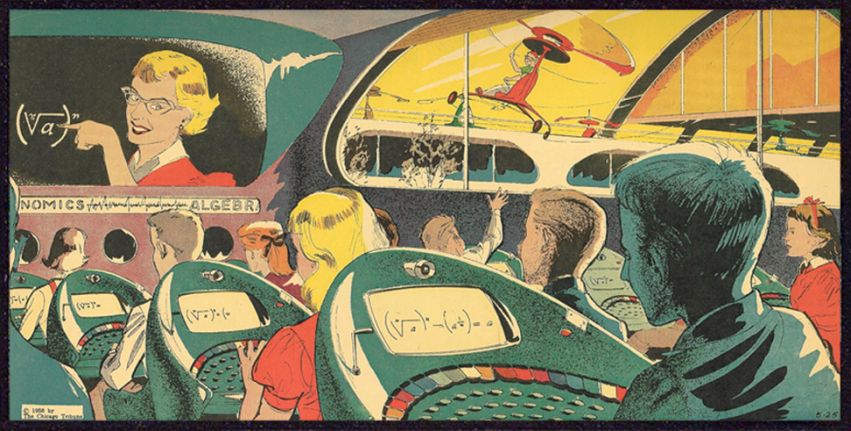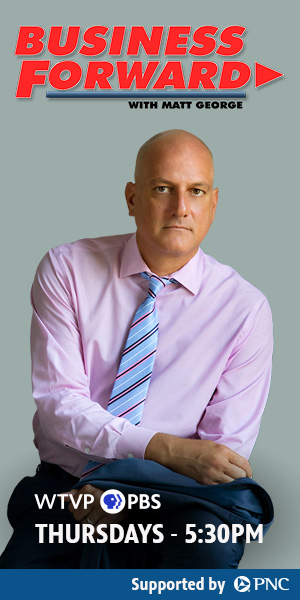“The best way to predict your future is to create it.”
—President Abraham Lincoln
Perhaps it is only appropriate, in the Land of Lincoln, that we are guided by Lincoln’s quote, as we embark on the time-honored tradition of attempting to predict the future. To be certain, there is an abundance of evidence over the past century of our collective attempts to envision what the “classroom of tomorrow” will look like. Sometimes these predictions seem naïve in hindsight—such as Thomas Edison’s 1922 claim that motion pictures would “revolutionize our educational system” and “supplant largely, if not entirely, the use of textbooks.”
Other predications appear almost prophetic, having been realized by future generations. One of the most prolific and accurate prognosticators was Arthur Radebaugh, illustrator of “Closer Than We Think,” a comic strip published from 1958 to 1963 for the Chicago Tribune-New York News Syndicate. He predicted that students would be using a computer-like device to learn algebra while being taught by a remote teacher, as seen in the accompanying 1958 illustration.
Future historians and sociologists will undoubtedly assert that COVID-19 was the primary determining factor that served to define the zeitgeist of the 2020s. Indeed, as a result of this global pandemic, we have already experienced an alteration in our social and economic fabric that has not been witnessed for generations. This dramatic societal shift includes how we perceive P-12 education. It has placed us in the position of again attempting to predict how our collective experience navigating this pandemic will shape our definition of P-12 education and the accompanying teaching and learning environment that we create.
The pandemic served to remind everyone in society just how inextricably linked our lives are with the institution of P-12 education. The magnitude of this reminder was felt across the nation and globally. To illustrate this point, the United Nations reported that 94 percent of the over 1.5 billion students throughout the globe were negatively impacted by the COVID-19 pandemic. This has upended and dramatically altered the educational landscape.
Therefore—as we look optimistically to the upcoming 2021-22 school year, and cautiously plan for a full return to in-person instruction in P-12 classrooms—we must take this opportunity to reflect back on the lessons learned over the past year and use them to guide us moving forward.
As Secretary of Education Miguel Cardona observed in a recent article published in The Washington Post, “There may be an opportunity to reimagine what schools will look like.” To this end, it is important to highlight some of the lessons learned or takeaways from the pandemic that truly can serve to guide or inform P-12 education in the years to come.
A Virtual Bridge
The first lesson evolved out of necessity, as P-12 teachers and administrators found themselves faced with the challenge of maintaining continuity of instructional delivery, academic rigor and pedagogical fidelity in the midst of a global pandemic. This required teachers and students to pivot from an in-person classroom environment to an online or remote environment, which demanded collaboration and outreach. The resulting remote learning environments, both synchronous and asynchronous, formed during the pandemic served to strengthen the connection between schools and communities, as well as break down the limits of a traditional classroom.
While this was seen by many as a temporary “fix”—in place until the world successfully navigated its way through the pandemic— teachers began to recognize it was actually an extension, albeit virtual, of the same relationship in which they were already engaged prior to the pandemic: to establish a collaborative partnership with parents in support of students’ learning. As a result, the virtual learning environment that was developed during the pandemic, which helped to further build upon the foundation that had already been established, will continue to serve as a curricular bridge between the classroom and home.
Equitable Access to Technology
A second takeaway from the pandemic is the realization that access to state-of-the-art technology and reliable broadband Internet access is a right that must be afforded to all students. While the pandemic did not create today’s digital divide, in which there is disparity relative to the availability of these essential digital resources, it has shed light on the problem. It also served as a catalyst for government to provide additional funding to support the efforts of school districts to address this divide—whether through their own initiatives or those launched in cooperation with community and business partners. These efforts ranged from providing millions of digital devices to students, to strategically placed WiFi-equipped school buses to serve as Internet hotspots in the community.
While further progress still needs to be made to address the digital divide, the innovative programs that were developed and the national attention this problem received during the pandemic has helped to provide momentum. Moving forward, this momentum must be accelerated as the role of online teaching and learning continues to evolve and grow in importance.
The New Normal
Perhaps the greatest takeaway from the pandemic is the realization that we will not be returning to “normal” in P-12 education. At a minimum, there will be a “new normal” that incorporates what we have learned during the pandemic, relative to how we teach and the type of teaching and learning environment in which we teach.
As Paul Reville, founding director of Harvard University’s Education Redesign Lab, reminds us, “It’s like a genie that is out of the bottle, and I don’t think you can get it back in… [and in] many respects, this is overdue.” It represents an opportunity to reimagine P-12 education in light of what has been learned and to address the issues of digital inequality that preceded the pandemic, as well as an opportunity for innovation, guided by the lessons teachers and administrators have learned over the course of the past year and a half.
In the end, perhaps the pandemic, which Dartmouth philosophy professor Marcelo Gleiser has referred to as a “turnaround point in human history… [that] is offering us a chance to reinvent ourselves,” presents us with an opportunity, as well, to redefine the educational landscape of the 21st century. PM




